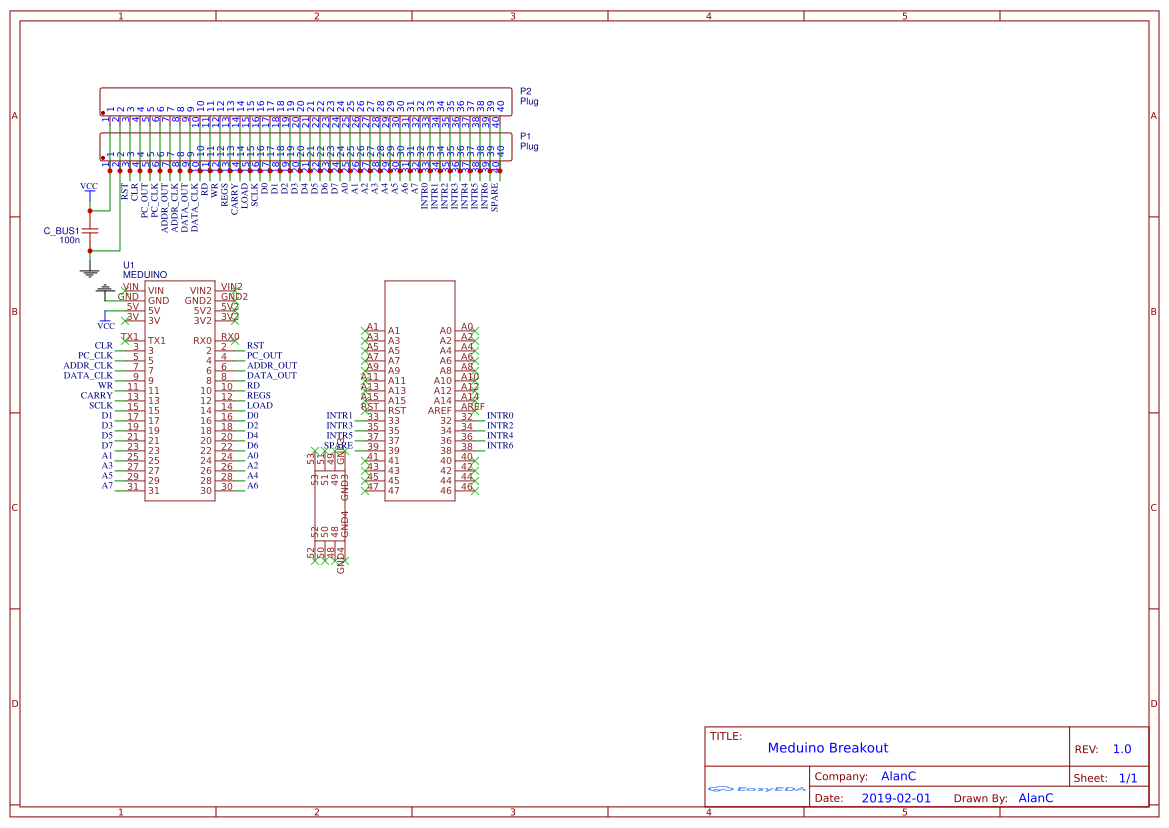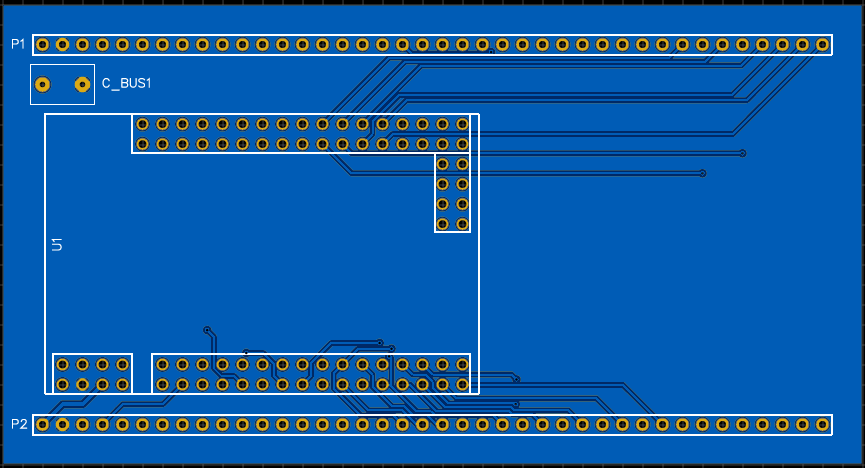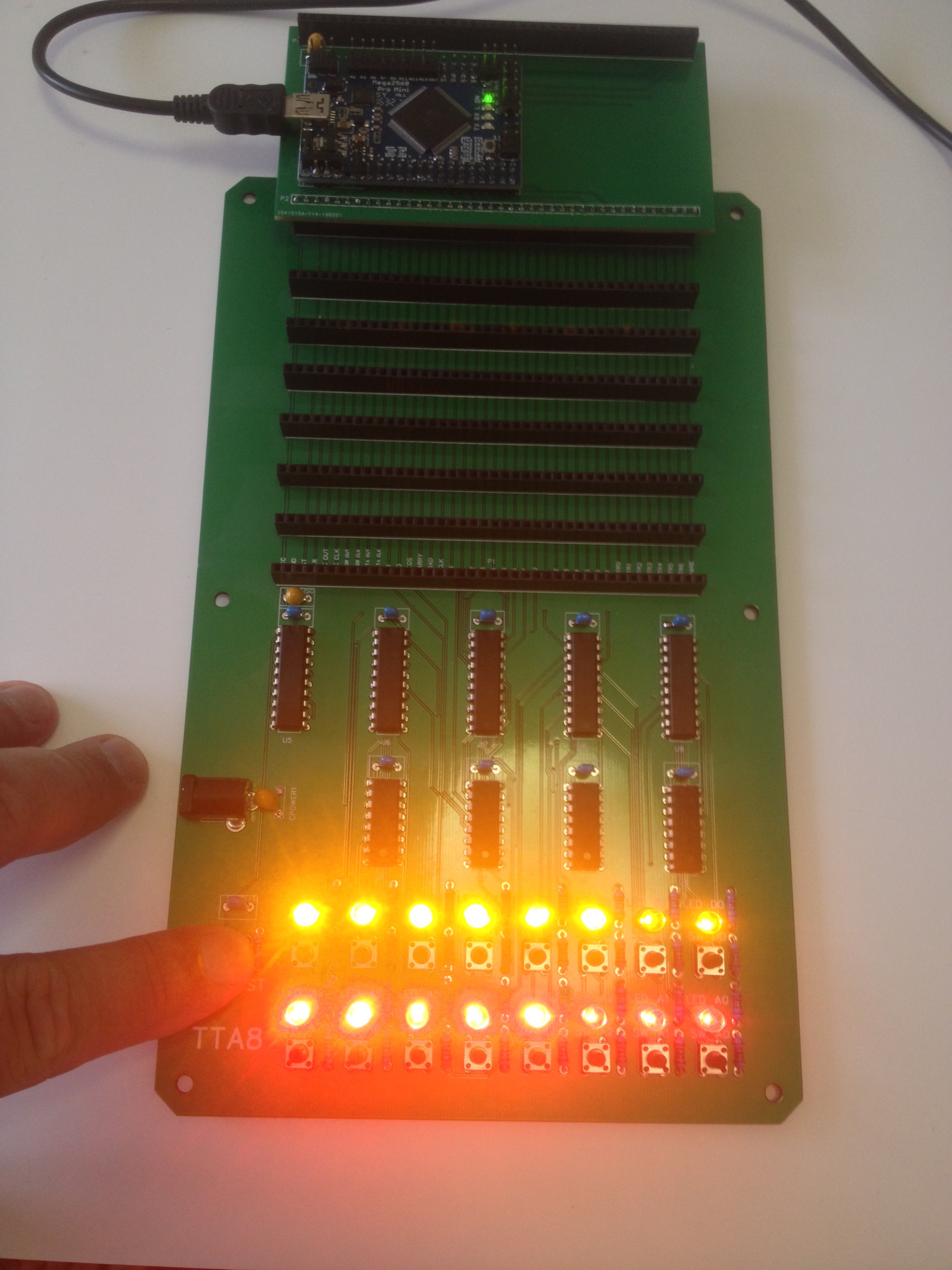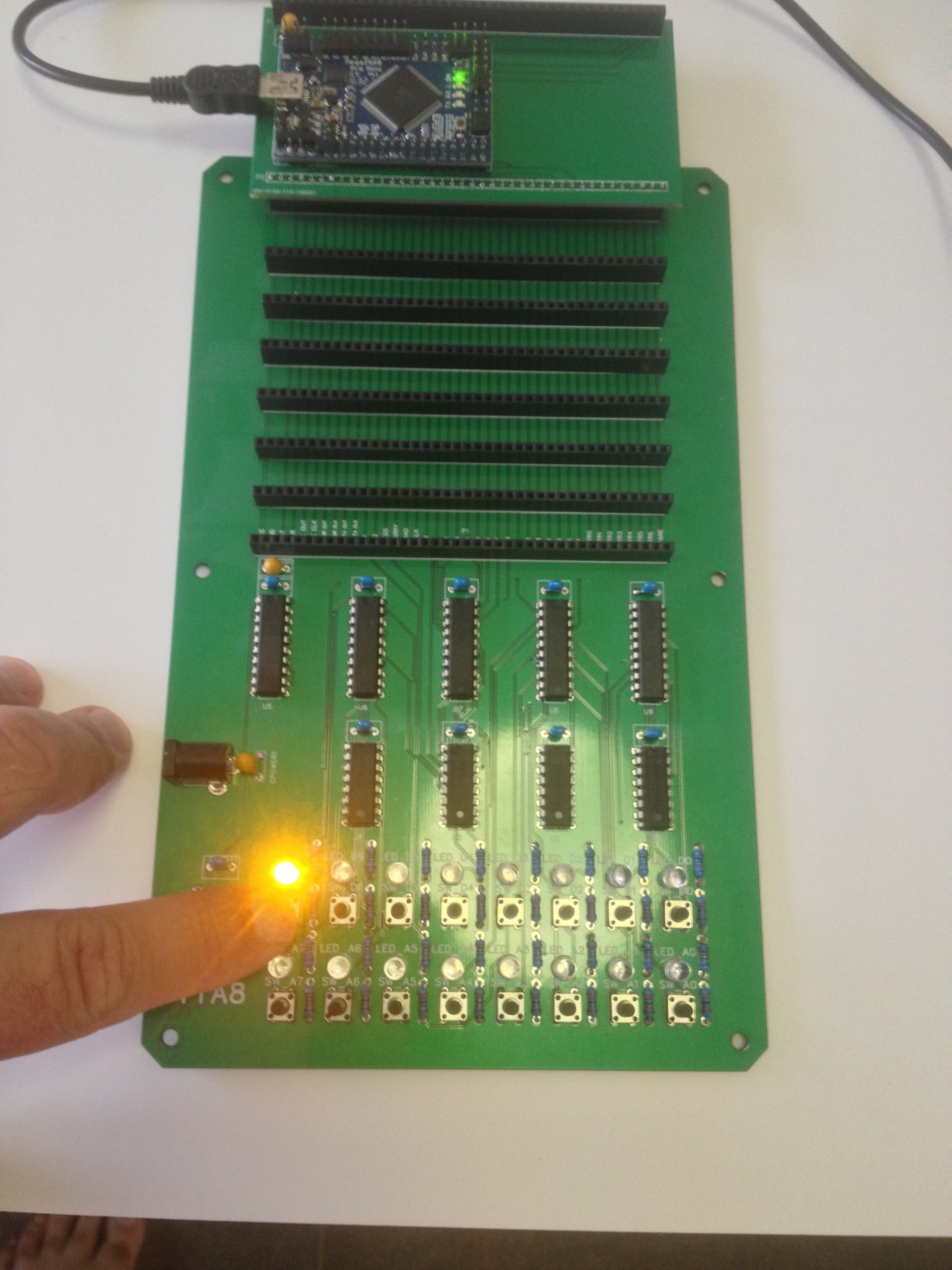Debugging
Need to get this project working.
One problem is that the Nano does not have enough pins.
So I have used a Meduino (a Mega2560 Pro Mini).
Here is the schematic:

Here is the PCB:

The ports (P1 & P2) match the TTA8 bus.
A problem with the Meduino is that pins do not align with the ports (unlike the Nano).
So it is awkward to go fast. Awkward just means more coding. But do I really need to go fast? This time I have coded using pinMode, digitalRead and digitalWrite.
Here is the Mother Board I/O test code:
/*
Front Panel Board Test
======================
REGISTERS:
Hex Address Write Read Comment
FF 255 JMP INTR Jump/Intr
FE 254 JC Reserved Jump on Carry
FD 253 ROM Reserved ROM PAGE
FC 252 RAM Reserved RAM PAGE
FB 251 REGD REGD DATA REG
FA 250 REGA REGA DATA REG ADDR
F9 249 REGQ NAND ALU
F8 248 REGP ADD ALU
SYSTEM (Pointer to Pointer Copy):
Hex Address Write Read Comment
F7 247 JUMP JUMP
F6 246 POINTER POINTER
F5 245 DEPOSIT DEPOSIT
F4 244 FETCH FETCH
F3 243 DATA DATA
F2 242 ADDR ADDR
F1 241 RETURN RETURN
F0 240 PAGE PAGE
CPU MODEL:
Hex Address Write Read Comment
EF 239 TEMP TEMP
EE 238 DELAY DELAY
ED 237 INTR INTR
EC 236 MASK MASK
EB 235 PP PP Page Pointer
EA 234 IP IP Instruction Pointer
E9 233 SP SP Return Stack Pointer
E8 232 DX DX (Monitor Data I/O)
E7 231 CX CX (Monitor Addr I/O)
E6 230 BX BX
E5 229 AX AX
E4 228 TX TX Temp Register
E3 STACK
E2 STACK
E1 STACK
E0 STACK
...
0xF8-0xFF REGISTERS (8 registers)
0xC0-0xF7 STATIC RAM (56 bytes at page 0xFF)
0x80-0xBF PAGED RAM (64 bytes)
0x00-0x7F PAGED ROM (128 bytes)
CPU Emulation:
This CPU has no actual opcodes.
All instructions are MOVE from [PC] to [PC+1]
i.e. Move DATA from source ADDRess to destination ADDRess.
The 4 cycles are:
1 Fetch the destination ADDRess pointed to by the program counter and put in the ADDR register
2 Fetch destination DATA pointed to by the ADDR register and put and the DATA register
2A Increment the program counter (PC)
3 Fetch destination ADDRess pointed to by the program counter and put in the ADDR register
4 Deposit the DATA register into the destination pointed to by the ADDR register
4A Increment the program counter (PC)
All hardware (PC,IO and ALU) is memory mapped.
*/
// Board Connections:
// Bus Meduino Pin
// VCC
// GND Gnd
#define RST 2
#define CLR 3
#define PC_OUT 4
#define PC_CLK 5
#define ADDR_OUT 6
#define ADDR_CLK 7
#define DATA_OUT 8
#define DATA_CLK 9
#define RD 10
#define WR 11
#define REGS 12
#define CARRY 13
#define LOAD 14
#define SCLK 15
#define Data0 16
#define Data1 17
#define Data2 18
#define Data3 19
#define Data4 20
#define Data5 21
#define Data6 22
#define Data7 23
#define Addr0 24
#define Addr1 25
#define Addr2 26
#define Addr3 27
#define Addr4 28
#define Addr5 29
#define Addr6 30
#define Addr7 31
#define Intr0 32
#define Intr1 33
#define Intr2 34
#define Intr3 35
#define Intr4 36
#define Intr5 37
#define Intr6 38
#define Spare 39
void InitialiseBoard(void)
{ // Reset State
pinMode(RST,INPUT_PULLUP); // Dont care
pinMode(CLR,OUTPUT); digitalWrite(CLR,LOW);
pinMode(PC_OUT,OUTPUT); digitalWrite(PC_OUT,LOW);
pinMode(PC_CLK,OUTPUT); digitalWrite(PC_CLK,LOW);
pinMode(ADDR_OUT,OUTPUT); digitalWrite(ADDR_OUT,HIGH);
pinMode(ADDR_CLK,OUTPUT); digitalWrite(ADDR_CLK,LOW);
pinMode(DATA_OUT,OUTPUT); digitalWrite(DATA_OUT,HIGH);
pinMode(DATA_CLK,OUTPUT); digitalWrite(DATA_CLK,LOW);
pinMode(RD,OUTPUT); digitalWrite(RD,HIGH);
pinMode(WR,OUTPUT); digitalWrite(WR,HIGH);
pinMode(REGS,OUTPUT); digitalWrite(REGS,HIGH);
pinMode(CARRY,OUTPUT); digitalWrite(CARRY,LOW);
pinMode(LOAD,OUTPUT); digitalWrite(LOAD,HIGH);
pinMode(SCLK,OUTPUT); digitalWrite(SCLK,HIGH);
pinMode(Data0,INPUT_PULLUP);
pinMode(Data1,INPUT_PULLUP);
pinMode(Data2,INPUT_PULLUP);
pinMode(Data3,INPUT_PULLUP);
pinMode(Data4,INPUT_PULLUP);
pinMode(Data5,INPUT_PULLUP);
pinMode(Data6,INPUT_PULLUP);
pinMode(Data7,INPUT_PULLUP);
pinMode(Addr0,OUTPUT); digitalWrite(Addr0,LOW);
pinMode(Addr1,OUTPUT); digitalWrite(Addr1,LOW);
pinMode(Addr2,OUTPUT); digitalWrite(Addr2,LOW);
pinMode(Addr3,OUTPUT); digitalWrite(Addr3,LOW);
pinMode(Addr4,OUTPUT); digitalWrite(Addr4,LOW);
pinMode(Addr5,OUTPUT); digitalWrite(Addr5,LOW);
pinMode(Addr6,OUTPUT); digitalWrite(Addr6,LOW);
pinMode(Addr7,OUTPUT); digitalWrite(Addr7,LOW);
pinMode(Intr0,INPUT_PULLUP);
pinMode(Intr1,INPUT_PULLUP);
pinMode(Intr2,INPUT_PULLUP);
pinMode(Intr3,INPUT_PULLUP);
pinMode(Intr4,INPUT_PULLUP);
pinMode(Intr5,INPUT_PULLUP);
pinMode(Intr6,INPUT_PULLUP);
pinMode(Spare,INPUT_PULLUP);
}
bool Reset(void)
{
byte data;
data=digitalRead(RST);
if (data==0) {
digitalWrite(CLR,LOW);
return true;
} else {
digitalWrite(CLR,HIGH);
return false;
}
}
byte ReadAddr(byte addr)
{
byte data;
// SET DATABUS TO INPUT
pinMode(Data0,INPUT_PULLUP);
pinMode(Data1,INPUT_PULLUP);
pinMode(Data2,INPUT_PULLUP);
pinMode(Data3,INPUT_PULLUP);
pinMode(Data4,INPUT_PULLUP);
pinMode(Data5,INPUT_PULLUP);
pinMode(Data6,INPUT_PULLUP);
pinMode(Data7,INPUT_PULLUP);
// SELECT ADDRESS
digitalWrite(Addr0,addr&1);
digitalWrite(Addr1,(addr>>1)&1);
digitalWrite(Addr2,(addr>>2)&1);
digitalWrite(Addr3,(addr>>3)&1);
digitalWrite(Addr4,(addr>>4)&1);
digitalWrite(Addr5,(addr>>5)&1);
digitalWrite(Addr6,(addr>>6)&1);
digitalWrite(Addr7,(addr>>7)&1);
// READ DATA
if (addr>=248) digitalWrite(REGS,LOW);
digitalWrite(RD,LOW);
delayMicroseconds(10);
data=digitalRead(Data0);
data|=digitalRead(Data1)<<1;
data|=digitalRead(Data2)<<2;
data|=digitalRead(Data3)<<3;
data|=digitalRead(Data4)<<4;
data|=digitalRead(Data5)<<5;
data|=digitalRead(Data6)<<6;
data|=digitalRead(Data7)<<7;
digitalWrite(RD,HIGH);
if (addr>=248) digitalWrite(REGS,HIGH);
return(data);
}
void WriteAddr(byte addr,byte data)
{
// SELECT ADDRESS
digitalWrite(Addr0,addr&1);
digitalWrite(Addr1,(addr>>1)&1);
digitalWrite(Addr2,(addr>>2)&1);
digitalWrite(Addr3,(addr>>3)&1);
digitalWrite(Addr4,(addr>>4)&1);
digitalWrite(Addr5,(addr>>5)&1);
digitalWrite(Addr6,(addr>>6)&1);
digitalWrite(Addr7,(addr>>7)&1);
// WRITE DATA
if (addr>=248) digitalWrite(REGS,LOW);
pinMode(Data0,OUTPUT);
pinMode(Data1,OUTPUT);
pinMode(Data2,OUTPUT);
pinMode(Data3,OUTPUT);
pinMode(Data4,OUTPUT);
pinMode(Data5,OUTPUT);
pinMode(Data6,OUTPUT);
pinMode(Data7,OUTPUT);
digitalWrite(Data0,data&1);
digitalWrite(Data1,(data>>1)&1);
digitalWrite(Data2,(data>>2)&1);
digitalWrite(Data3,(data>>3)&1);
digitalWrite(Data4,(data>>4)&1);
digitalWrite(Data5,(data>>5)&1);
digitalWrite(Data6,(data>>6)&1);
digitalWrite(Data7,(data>>7)&1);
digitalWrite(WR,LOW);
delayMicroseconds(10);
digitalWrite(WR,HIGH);
if (addr>=248) digitalWrite(REGS,HIGH);
// RESET DATABUS
pinMode(Data0,INPUT_PULLUP);
pinMode(Data1,INPUT_PULLUP);
pinMode(Data2,INPUT_PULLUP);
pinMode(Data3,INPUT_PULLUP);
pinMode(Data4,INPUT_PULLUP);
pinMode(Data5,INPUT_PULLUP);
pinMode(Data6,INPUT_PULLUP);
pinMode(Data7,INPUT_PULLUP);
}
void setup() {
// Fire up the board
InitialiseBoard();
// Serial.begin(9600);
// while (!Serial);
// Serial.println();
}
void loop() {
byte A=0;
// Check reset button
if (!Reset()) {
// ADDR LEDs and Switches
WriteAddr(0XFA,0X00);
A=ReadAddr(0XFB);
WriteAddr(0XFB,A);
// DATA LEDs and Switches
WriteAddr(0XFA,0X01);
A=ReadAddr(0XFB);
WriteAddr(0XFB,A);
} else {
// RESET State
// ADDR LEDs
WriteAddr(0XFA,0X00);
WriteAddr(0XFB,0xFF);
// DATA LEDs
WriteAddr(0XFA,0X01);
WriteAddr(0XFB,0xFF);
}
delay(100);
}
Testing
Fired up first time! Wow! Okay, I know the Mother Board works.
Here is the reset:

Here is A7:

And D7:

Trust me the rest work.
ALU Board
Next is the ALU Board. It works, no surprise as it tested out before.
ROM/RAM/StaticRAM Board
No it does not work. So far I have found two errors. The ROM page and RAM page are swapped, and the Static RAM (Addresses 192 to 247) are latched (wrong).
I forgot that the ROM/RAM pages are latched by a jump (i.e. JC or JMP).
For testing purposes I can fix these in software but still I cannot read the ROM or RAM data. I have to rework the code to make it easier to log the bus (i.e with a bus analyser).
Still no life out of the board. So the it is a chip select problem. Yes, U4 expects REGS high but I design REGS low.
Fix. I can't fix this in software so time for a new board.
Interrupt Board
This board generates SCLK which is 38400 Hz. It uses the WR signal from the Controller Board. There is always a WR (and a RD) every 8 clock cycles (no more and no less).
Interrupts Intr0 through to Intr6 are external while Intr7 is connected to a 2400 Hz clock (SCLK/16). The interrupt address is 0xFF (read only). Reading the interrupt address clears Intr7. Intr& is used to control the serial card (along with SCLK).
Anyway, my tests tell me the Interrupt/Timing Board is working.
Program Counter Board
This board is controlled by the Controller Board (which previously tested okay (at least by the logic analyzer)).
Other than the Serial Board, this is the last board to test.
New Paged Memory Board
Populated the new Paged Memory Board.
Plug in Mother Board - Fail.
Test the Paged Memory Card:
- Tested Paged RAM - check.
- Tested Static RAM - check.
- Tested Paged ROM:
- Page 0 - Corrupted.
- Pages 1+ - Okay.
Check FRAM in programmer:
- Check - Page 0 correupted.
- Reprogram FRAM
Recheck Paged Memory Card:
- Check - All good.
Plug in Mother Board - Fail.
Test the Paged Memory Card:
- Page 0 - Corrupted.
- Otherwise all good.
This means something is writing to the FRAM as the WR signal is exposed.
Could be code or hardware responsible.
Something to look at tomorrow, otherwise progress has been made.
---
I set Software Data Protection (SDP) mode on the AT29C256 FRAM.
At least I think I have? I will find out shortly.
Anyway should not have to reprogram the FRAM after each test.
Now to find out why, is it the Monitor code or a hardware problem?
AlanX
 agp.cooper
agp.cooper
Discussions
Become a Hackaday.io Member
Create an account to leave a comment. Already have an account? Log In.